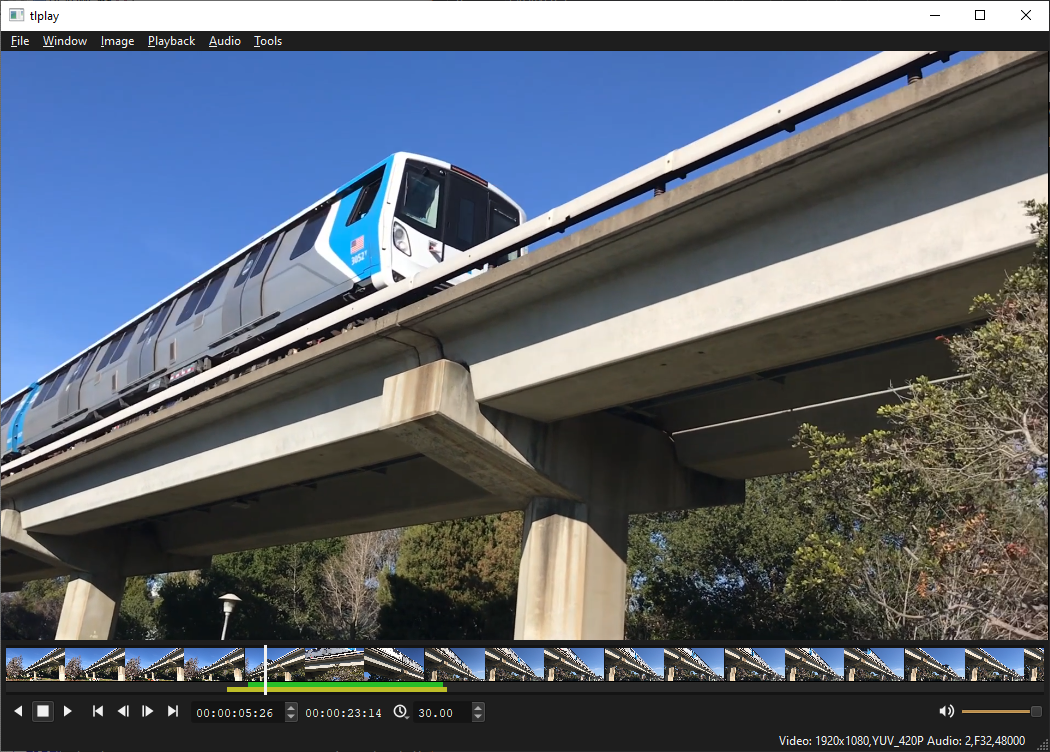tlRender is an open source library for building playback and review applications for visual effects, film, and animation.
The library can render and playback timelines with multiple video clips, image sequences, audio clips, and transitions. Examples are provided for integrating the library with Qt and GLFW applications.
The source code is written in C++14 and uses CMake for the build system.
Currently supported:
- Movie files (H264, MP4, etc.)
- Image file sequences (Cineon, DPX, JPEG, OpenEXR, PNG, PPM, TIFF)
- Multi-channel audio
- Color management
- A/B comparison
To do:
- Software rendering
- Apple Metal rendering
- Microsoft DirectX rendering
- Effects
- GPU movie decoding
- Nested timelines
- Python bindings
Contents:
The core libraries providing timeline rendering, playback, and I/O.
Required dependencies:
Optional dependencies:
Library for rendering timelines with OpenGL.
Libraries for integrating with Qt based applications.
Required dependencies:
Play timelines, movies, and image sequences.
Render a timeline to a movie or image sequence.
A CMake super build script is provided to build the dependencies from source, except for Qt. Qt should be installed separately.
| Name | Description | Default |
|---|---|---|
| TLRENDER_MMAP | Enable memory-mapped file I/O | TRUE |
| TLRENDER_COVERAGE | Enable code coverage | FALSE |
| TLRENDER_PYTHON | Enable Python support (for OTIO Python adapters) | FALSE |
| TLRENDER_OCIO | Enable support for OpenColorIO | TRUE |
| TLRENDER_AUDIO | Enable support for audio | TRUE |
| TLRENDER_FREETYPE | Enable support for FreeType font rendering | TRUE |
| TLRENDER_JPEG | Enable support for JPEG | TRUE |
| TLRENDER_TIFF | Enable support for TIFF | TRUE |
| TLRENDER_PNG | Enable support for PNG | TRUE |
| TLRENDER_EXR | Enable support for OpenEXR | TRUE |
| TLRENDER_FFMPEG | Enable support for FFmpeg | TRUE |
| TLRENDER_GL | Enable support for OpenGL | TRUE |
| TLRENDER_BMD | Enable support for Blackmagic Design devices | FALSE |
| TLRENDER_BMD_SDK | Full path to the Blackmagic Design SDK | "" |
| TLRENDER_QT6 | Enable support for Qt6 | FALSE |
| TLRENDER_QT5 | Enable support for Qt5 | FALSE |
| TLRENDER_PROGRAMS | Build programs | TRUE |
| TLRENDER_EXAMPLES | Build examples | TRUE |
| TLRENDER_TESTS | Build tests | TRUE |
Clone the repository:
git clone https://github.com/darbyjohnston/tlRender.git
cd tlRender
git submodule init
git submodule update
Create a build directory:
mkdir build
cd build
Run CMake with the super build script:
cmake ../etc/SuperBuild -DCMAKE_INSTALL_PREFIX=$PWD/install -DCMAKE_PREFIX_PATH=$PWD/install -DCMAKE_BUILD_TYPE=Debug
Start the build:
cmake --build . -j 4 --config Debug
Try running the "play-glfw" example:
export LD_LIBRARY_PATH=$PWD/install/lib:$LD_LIBRARY_PATH
./tlRender/src/tlRender-build/examples/play-glfw/play-glfw ../etc/SampleData/MultipleClips.otio
When running CMake with the super build script, add the Qt location to "CMAKE_PREFIX_PATH" (make sure to use quotes), and enable "TLRENDER_QT5":
cmake ../etc/SuperBuild -DCMAKE_INSTALL_PREFIX=$PWD/install -DCMAKE_PREFIX_PATH="$PWD/install;$HOME/Qt/5.15.2/gcc_64" -DTLRENDER_QT5=ON -DCMAKE_BUILD_TYPE=Debug
Build with only the required dependencies, disabling all optional dependencies.
cmake ../etc/SuperBuild -DCMAKE_INSTALL_PREFIX=$PWD/install -DCMAKE_PREFIX_PATH=$PWD/install -DCMAKE_BUILD_TYPE=Debug -DTLRENDER_OCIO=OFF -DTLRENDER_AUDIO=OFF -DTLRENDER_FREETYPE=OFF -DTLRENDER_JPEG=OFF -DTLRENDER_TIFF=OFF -DTLRENDER_PNG=OFF -DTLRENDER_EXR=OFF -DTLRENDER_FFMPEG=OFF -DTLRENDER_PROGRAMS=OFF -DTLRENDER_EXAMPLES=OFF -DTLRENDER_TESTS=OFF
Example for running gcovr for code coverage:
gcovr -r ../../../../lib --html --object-directory lib --html-details --output gcov.html lib/tlCore lib/tlIO lib/tlTimeline
Clone the repository:
git clone https://github.com/darbyjohnston/tlRender.git
cd tlRender
git submodule init
git submodule update
Create a build directory:
mkdir build
cd build
Run CMake with the super build script:
cmake ../etc/SuperBuild -DCMAKE_INSTALL_PREFIX=$PWD/install -DCMAKE_PREFIX_PATH=$PWD/install -DCMAKE_BUILD_TYPE=Debug
Start the build:
cmake --build . -j 4 --config Debug
Try running the "play-glfw" example:
./tlRender/src/tlRender-build/examples/play-glfw/play-glfw ../etc/SampleData/MultipleClips.otio
When running CMake with the super build script add the Qt location to "CMAKE_PREFIX_PATH" (make sure to use quotes), and enable "TLRENDER_QT5":
cmake ../etc/SuperBuild -DCMAKE_INSTALL_PREFIX=$PWD/install -DCMAKE_PREFIX_PATH="$PWD/install;$HOME/Qt/5.15.2/clang_64" -DTLRENDER_QT5=ON -DCMAKE_BUILD_TYPE=Debug
The CMake variable "CMAKE_OSX_ARCHITECTURES" can be used to specify the build architecture:
-DCMAKE_OSX_ARCHITECTURES=x86_64
-DCMAKE_OSX_ARCHITECTURES=arm64
Most of the third party software that tlRender depends upon is built as part of the CMake super build, except for FFmpeg on Windows. Instead the Windows Subsystem for Linux (WSL) is used to compile FFmpeg as a separate step before the CMake super build.
Enable the Windows Subsystem for Linux:
- Open the Windows control panel and click on "Programs and Features"
- Click on "Turn Windows features on or off" on the left side of the "Programs and Features" window
- Check the "Windows Subsystem for Linux" item in the "Windows Features" window
- Restart your computer
Install Ubuntu from the Windows app store, then open a shell and install necessary software:
sudo apt update
sudo apt install mingw-w64 yasm make unzip
Build FFmpeg, replacing $SOURCE_DIR and $BUILD_DIR with the same directories used in the "Building on Windows" section:
$SOURCE_DIR/etc/Windows/build_ffmpeg_wsl.sh $BUILD_DIR/install
Clone the repository:
git clone https://github.com/darbyjohnston/tlRender.git
cd tlRender
git submodule init
git submodule update
Create a build directory:
mkdir build
cd build
Run CMake with the super build script:
cmake ..\etc\SuperBuild -DCMAKE_INSTALL_PREFIX=%CD%\install -DCMAKE_PREFIX_PATH=%CD%\install -DCMAKE_BUILD_TYPE=Debug
Start the build:
cmake --build . -j 4 --config Debug
Try running the "play-glfw" example:
set PATH=%CD%\install\bin;%PATH%
.\tlRender\src\tlRender-build\examples\play-glfw\Debug\play-glfw ..\etc\SampleData\MultipleClips.otio
When running CMake with the super build script add the Qt location to "CMAKE_PREFIX_PATH" (make sure to use quotes), and enable "TLRENDER_QT5":
cmake ..\etc\SuperBuild -DCMAKE_INSTALL_PREFIX=%CD%\install -DCMAKE_PREFIX_PATH="%CD%\install;C:\Qt\5.15.2\msvc2019_64" -DTLRENDER_QT5=ON -DCMAKE_BUILD_TYPE=Debug

